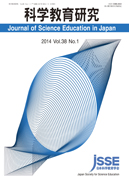All issues

Volume 30, Issue 1
Displaying 1-7 of 7 articles from this issue
- |<
- <
- 1
- >
- >|
-
[in Japanese]2006 Volume 30 Issue 1 Pages 1-2
Published: March 10, 2006
Released on J-STAGE: June 30, 2017
JOURNAL FREE ACCESSDownload PDF (324K) -
Shoko SAKATA, Yoshisuke KUMANO2006 Volume 30 Issue 1 Pages 3-13
Published: March 10, 2006
Released on J-STAGE: June 30, 2017
JOURNAL FREE ACCESSScience Education in Japan begins only at 3^<rd> grade in Elementary school. Prior to this, children from the ages of 3 to 8 receive no formal science education or school-science education. In this research, the main focus is on the development of a vision for design of early childhood science education activities within a Japanese context. In order to develop a vision for the designing the activities, we need to analyze several things. First, we need to analyze the status of early childhood education in Japan. Second, we need to analyze the cognitive development of children themselves. We also need to consider other countries, for example the United States and Canada, where science education for early childhood has already been well developed. Moreover, the rationale for the acquisition of scientific literacy and global science literacy for young children is discussed. As a result of an over all discussion of scientific literacy and the present situation, a vision for design of science education activity for young children is developed. Finally, in consideration of scientific literacy, five science education activity examples are described.View full abstractDownload PDF (1085K) -
Kazushige MIZOBE, Shigenori INAGAKI2006 Volume 30 Issue 1 Pages 14-26
Published: March 10, 2006
Released on J-STAGE: June 30, 2017
JOURNAL FREE ACCESSThis research is a seguel to a study of the Akashi Plan (1949), conducted by K. Mizobe and S. Inagaki (in press). The research aims to clarify how science education was dealt with in the Akashi Plan (1953), a representative example of core education curricula, comprising three courses: the Core course, the Daily life course, and the Basic course. The study results were as follows: -The Core course contained goals and curricula of science education. However, the percentage of study units containing science related curricula accounted for only about 40% of all study units. -In the Daily life course, more than 40% of all activities exemplified were relevant to science education. -The Basic course set up science categories in which goals and the science education curricula were indicated. Some curricula in the Basic course were relevant to those of the other two courses. Meanwhile, teaching guidelines for the Basic course were designed to instruct students independently of the Core course. As shown in the study results referred above, the Akashi Plan (1953) included goals of science education in its Core and Basic courses. The study results also show that all three courses in the Akashi Plan had relevance for science education, though levels of emphasis on science education differed according to the curricula. Moreover, while each course was related to other courses in terms of science education, teaching guidelines for the Basic course were designed to instruct students independent of the Core course.View full abstractDownload PDF (1337K) -
Mayumi TAKAGAKI2006 Volume 30 Issue 1 Pages 27-36
Published: March 10, 2006
Released on J-STAGE: June 30, 2017
JOURNAL FREE ACCESSThis research involved implementing a lesson to change preconceptions about the change of water state (air bubblessteam bubbleswater) by introducing self-generated analogies and software for animation models as cognitive tools to a fourth grade elementary school science class. In order to examine what conceptual changes occurred and what underlying factors affected these changes during the argumentation process of the cooperative learning session held in small groups, interactive analysis of verbalization activity derived from TD (transactive discussion) was dimenstionalized. As a result, it was suggested that the following activities are involved as factors that induce conceptual changes. (1) Discussion, which generates an operational transaction in the direction of other-transformation or self-transformation. (2) Study in the form of "using self-generated analogies as a cognitive tool, and repeating the process of analogy generation, recognition and modification." (3) Instruction that "introduces software for animation models, and facilitates perception of the causal relations of hydraulic behavior in the change of water state as plausible."View full abstractDownload PDF (1156K) -
Takeshi KITAZAWA, Hiroshi KATO, Kanji AKAHORI2006 Volume 30 Issue 1 Pages 37-47
Published: March 10, 2006
Released on J-STAGE: June 30, 2017
JOURNAL FREE ACCESSThis paper describes how elementary school students acknowledged our science e-learning site, "Science Net," in order to analyze the effectiveness of the site as a form of blended learning. The authors examine the relationship between the consequent effectiveness of learning via post-questionnaires and the frequency and purposes of students' access to "Science Net." The results show that the contents of "schedules of lessons" not only serve the purpose of allowing students to prepare for the next lesson but also provide useful science education. In addition, students report that they find it useful for checking lessons when they are absent as they are able to download worksheets and ask questions to the teacher via a bulletin board system (BBS). In addition, models imply that the students who access "Science net" frequently use the system not only as a means to review but also as a means to prepare for the future.View full abstractDownload PDF (1929K) -
[in Japanese]2006 Volume 30 Issue 1 Pages 48-50
Published: March 10, 2006
Released on J-STAGE: June 30, 2017
JOURNAL FREE ACCESSDownload PDF (326K) -
[in Japanese]2006 Volume 30 Issue 1 Pages 51-53
Published: March 10, 2006
Released on J-STAGE: June 30, 2017
JOURNAL FREE ACCESSDownload PDF (311K)
- |<
- <
- 1
- >
- >|